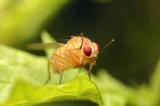The “Humble” fruit fly helps University of Warwick scientists understand human heart development
Scientists at the University of Warwick have been awarded nearly £300,000 from the British Heart Foundation (BHF) to study tiny fruit fly hearts to help understand how the human heart is formed.
Each day in the UK, around 13 babies are diagnosed with a congenital heart defect – a condition that develops in the womb before the baby is born. Scientists are keen to understand why this happens and one key to this is studying how the heart develops.
To help do this, BHF has awarded Dr Timothy Saunders and his team at the University of Warwick £290,038 for a three-year project to study fruit fly hearts to understand how genes interact when they come together in the embryo to create a heart.
A fruit fly, also known by its scientific name Drosophila melanogaster, is about 4mm in length while their eggs are about 0.5mm and can just be seen by the human eye.
But while a miniscule fruit fly heart might not much resemble a human heart, according to Dr Saunders the early stages of heart development are evolutionary conserved – meaning that studying the formation of the heart in one organism can help understand heart formation in another.
Dr Saunders highlighted that the genes specifying which cells become heart cells have already been identified using earlier research on flies and mice. But what remains unknown is how these genes interact with each other to define the distinct different heart cell types which ultimately “build” the heart.
Understanding this could help solve the puzzle of why some hearts develop abnormally in the womb.
“We are studying the humble fruit fly because although its heart is tiny and simple - it is basically a tube - the genes that make it are almost identical to those in a human heart,” said Dr Saunders. “Studying these genes as they interact to begin to develop the heart, combined with mathematical modelling, will enable us to decipher how the first heart cells are specified.”
Dr Saunders said that his ultimate vision for their research was that it could help understand human heart diseases and inform treatment for heart disease in the future. “This research won’t provide all the answers, but we hope that we can be one part of solving the puzzle,” he added.
BHF research advisor Dr Tian Yu said: “Today, thanks to research, more than eight out of 10 babies born with a congenital heart defect in the UK survive to adulthood. However, we don’t always know why their hearts haven’t developed properly and understanding this better could improve the way we diagnose and treat these conditions.
“This is why we’re delighted to be able to award this funding to Dr Saunders and his team. But we’re only able to do this thanks to the generosity of the public who support us, in our aim to beat heartbreak forever.”
Ends

